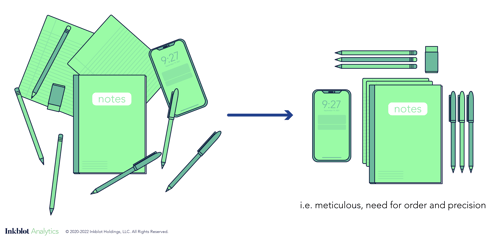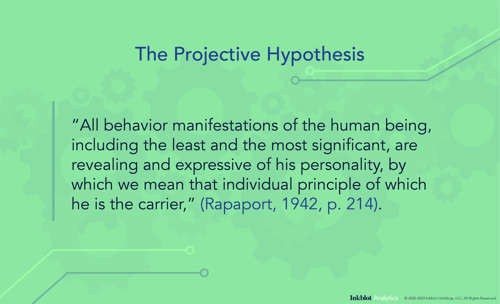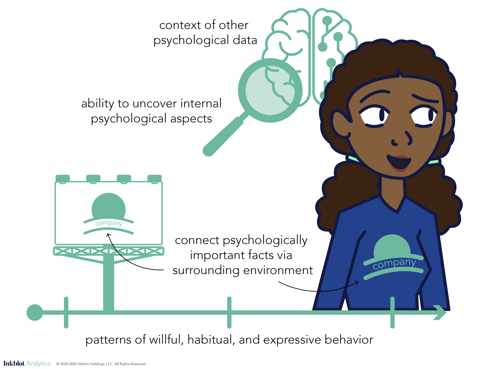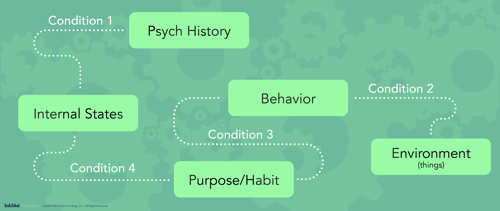What Are Projective Tests?
If you think you know what projective tests are, you may only know half the story.
Discover how psychologists used general principles and conceptual similarities of projection to establish the sub-discipline of projective assessments.
In our last post we explored the noteworthy etymology of the word projection. Its development carries many nuances—some of which are still the subject of debate—that contribute to the many uses and applications of the concept. While the origins of projection have their roots in psychoanalysis, the foundation of projective techniques was more widespread than one school of thought, and instead was built on general principles by which to study personality. This is a critical and commonly overlooked distinction, as these projective techniques were not originally involved with the processes of psychoanalytic projection, specifically the Freudian concept of defense mechanisms (Lindzey, 1961, p. 38). In this post, we’ll show you the logic of how psychologists used general principles and conceptual similarities of projection to establish the subdiscipline of projective assessments.
To understand the formal projective hypothesis, we must first understand the origin of projective methods.
The origins of projective techniques are intricately folded and somewhat convoluted. While there were many scholars who influenced the development of projective techniques, economist and educator Lawrence K. Frank proposed the term projective methods to describe the techniques used to “reveal the way an individual personality organizes experience, in order to disclose or at least gain insight into the individual’s private world of meanings, significances, patterns, and feelings” (Frank, 1939, p. 402).
Frank proposed that the study of personality should focus on the processes of organizing experiences (e.g., the experience when looking at inkblots) and psychological materials (e.g., meanings) in real-time, with respect to distinctive cultural patternings. This position is best captured by a psychocultural approach.

In his 1939 paper, Projective methods for the study of personality, Frank described the method where a personality—when provided with an interactive environment, or as he puts it, a “stimulus-situation”—can project this private world onto the environment. This occurs because the individual has to “organize the field, interpret the material and react affectively to it” (Frank, 1939, p. 403).
Frank noted that a “stimulus-situation” should—for the purposes of projecting inner mental states out into the environment—contain as little structural and social or cultural patterning as possible. Through the general mechanism of projection, a person may reveal aspects of their private world (i.e. personality). In particular, these projective techniques aim to reveal what the subject keeps private, or as Frank stated several times, “what he cannot or will not say” (Frank, 1939, p. 404, 408). While this private world indeed alludes to aspects of the non-conscious mind, it should not be confused with Freud’s conceptualization of repression and the individual’s unconscious act of keeping harmful content out of consciousness.
Frank’s writings touch on several topics that are foundational to the projective hypothesis. As such, Frank is commonly credited with coining the projective hypothesis, though the term itself was introduced later on.
In 1942 David Rapaport, a significant figure in psychoanalytic psychology, coined the term “Projective Hypothesis,” and defined this hypothesis as “all behavior manifestations of the human being, including the least and the most significant, are revealing and expressive of his personality, by which we mean that individual principle of which he is the carrier” (Rapaport, 1942, p. 214).

While the projective hypothesis set a foundation for projective science to grow upon, it did not provide a direct connection for how researchers in projective science should develop their own methods and tests.
Therefore, Rapaport outlined 4 conditions, built on the Projective Hypothesis, that are required for a psychological assessment to be a projective test:
The ability to understand projections in the context of other psychological data.
The ability to connect psychologically important facts via the surrounding environment.
The ability to focus on patterns of willful, habitual, and expressive behavior.
The ability to uncover internal psychological aspects of the individual.

Condition 1: The ability to understand projections in the context of other psychological data. This first condition of a projective technique is its ability to constitute individual facts about a person’s experience examined from interviews as well as personal records. These patterns of behavior, and in singular cases behavioral events, are useful for providing a foundation when analyzing an individual’s current state via projection. For example, if a person has a family history of psychiatric disorders that are unknown to an examiner, it could lead to alternative, uninformed explanations for their projections. A projective technique must allow for the ability to substantiate interpretations of projections in light of other psychological evidence, like life history data.
Condition 2: The ability to connect psychologically important facts via the surrounding environment. The second necessary condition for a projective technique is directly linked to what would later become a pillar of consumer psychology--the link between mind and materials. Rapaport provides the example of the clothes a person wears and the materials they decorate the interior of their home with. These products are seen as both functional (e.g. to stay warm in the winter, or protected from the sun during summer) and symbolic (e.g. as reflections of personal identity). But we only know that certain items are symbolic, or meaningful, if participants can indicate it as such within the test. Consequently, how the person organizes the surrounding environment helps connect the test data with psychologically important facts.
Condition 3: The ability to focus on patterns of willful, habitual, and expressive behavior. This third condition describes how important it is to note goal-oriented modifications to a specific environment, at a given time. These goal-oriented patterns reveal purpose-driven actions (or executions of will), which are critical for understanding the underlying aspects of personality (Allport, 1937).
Condition 4: The ability to uncover internal psychological aspects of the individual. The fourth condition requires that a projective technique should be able to get at the perceptions, thoughts, and fantasies behind behavior, which have direct ties to individual needs and concerns. At times there may be an inherent dissociation between the internal and external worlds. We may intend to behave in a certain way, but our actions could say otherwise. On the other hand—as in the case of projection—we may unknowingly cast out a shadow of the internal onto the external world.

Rapaport’s four necessary conditions, built on the projective hypothesis, help provide guidelines for projective methods. But the remaining question to most projective methodologists is what is the best activity to employ in their test? What rigorous process would allow us to truly focus on the internal psychological aspect of a person, reflected in the person’s environment by their expressive, purpose-driven behaviors, and validated with connections to other psychological data?
Rapaport suggests two activities that can be used in projective methods--choice and organization. Rapaport argued that the choices a person makes, and the manner in which they organize these choices, can be expressive of the personality. Rapaport contended that choice and organization are not entirely mutually exclusive, but rather two sides of the same coin. One becomes dominant over the other depending on the method used. However, only by understanding the pros and cons of each methodological approach can we gain a greater knowledge of the outcome of projection (Rapaport, 1942).
Consider a test where you choose which objects from a set belong with the sample object. One of the benefits of this approach is the open-ended observation of their concept formation (i.e., seeing in real time how they compare and contrast test objects with the sample object). However, a downside of choice methodologies is the potential limitations in a person’s ability to project by conventional response patterning. The key for choice-based methods is developing it in a way that circumvents cultural “default” patterns of responding.
On the other hand, if the test stimulus is more ambiguous, organization tends to dominate as the activity of choice. For example, a Rorschach inkblot test tells you about a subject’s perceptions of form, color, and shading as they ascribe meaning through organizing the features of the test material. There are a potentially unlimited number of ways to respond to the test’s stimulus according to individual interpretation.

Regardless of whether or not the activity employed is choice or organization, one thing is clear--whatever the stimulus is that they’re choosing or organizing, it has to be ambiguous to allow for their personal meaning to be projected onto it. As Frank said: “More specifically, a projection method for study of personality involves the presentation of a stimulus-situation designed or chosen because it will mean to the subject, not what the experimenter has arbitrarily decided it should mean (as in most psychological experiments using standardized stimuli in order to be “objective”), but rather whatever it must mean to the personality who gives it, or imposes open it, his private, idiosyncratic meaning and organization. The subject then will respond to his meaning of the presented stimulus-situation by some form of action and feeling that is expressive of his personality” (Frank, 1939, p. 403 ).
Rapaport proposed four additional sufficient criteria from a comparison of clinical observations. It is important to note that Rapaport outlined these four criteria as distinct advantages of projective techniques over subjective clinical observation.
Easy objective observation means that the test has no interpretive selection.
Easy objective registration allows for an uninhibited response to the stimulus.
Systematic scoring to compare within and between individuals posits that the projectively obtained material should be scored according to a schema.
Disguised tests mask the intentions of the projective techniques, such that the purpose of the test is unknown to the subject.
In Rapaport’s experience, clinical observation often yields subjective data in the sense that an interpretation is made from an infinite number of features of a given behavior. In other words, it is particularly susceptible to individual bias. Charles A. Dailey (1951,1960) elaborated on the faulty premises of assessment, suggesting that clinicians could predict with higher accuracy by accounting for the design of the test and how it is received by the subject. He also proposed three forms of bias that pervaded the practice of the time.
Pathological bias is a “tendency to see symptoms and defense mechanisms in everyone“ (Dailey, 1960, p. 20). Think back to our metaphor, “when you think like a hammer, everything looks like a nail.”
Abstract bias is the belief that personality is an abstract idea that is not closely related to behavior. In this view personality is static and intangible to the observer. Dailey proffered a quote from Abraham Maslow (1956) to describe the hazards of such a bias, “All intellectuals tend to become absorbed with abstractions, words and concepts, and forget … the fresh and concrete, the original real experience which is the beginning of all science” (Maslow, 1956, pp. 186).
Testing bias is the over reliance on standardized measurements and observations. Dailey concludes by calling for a change in cultural practice, in favor of a focus on increased importance on life-history methods and concepts.
Projective techniques offer an alternative form of psychological assessment. This usually makes it the subject of many critics. But Projective tests start with a fundamental axiom (i.e., the projective hypothesis), and have both necessary and sufficient guidelines for what is required to create them. Hopefully, by reading this post, you can see that there is a “method to the madness” when it comes to creating new projective tests, methods, and techniques.
[1] For a detailed account on the development of clinical practices, as well as the origination of the terms projective {tests, techniques, and methods} of projective techniques, please see pp. 31-38 in Gardner Lindzey’s 1961 book titled Projective techniques and cross-cultural research.
References:
Allport, G. W. (1937). Personality: a psychological interpretation. Holt.
Dailey, C. A. (1951). The clinician and his predictions. Journal of Clinical Psychology, 7, 270–273.
Dailey, C. A. (1960). The life history as a criterion of assessment. Journal of Counseling Psychology, 7(1), 20-23.
Frank, L. K. (1939). Projective methods for the study of personality. Journal of Psychology. 402-403.
James, W. (2007), [1890]. The Principles of Psychology Vol. 1. Cosimo, Inc. 292.
Lindzey, G. (1961). Projective techniques and cross-cultural research. Appleton-Century-Crofts. 31-38.
Maslow, A. H. (1956). Toward a humanistic psychology. ETC: A Review of General Semantics. 186.
Rapaport, D. (1942). Principles underlying projective techniques. Character & Personality; A Quarterly for Psychodiagnostic & Allied Studies, 10, 213–219.
Rapaport, D., Gill, M., & Schafer, R. (1946). Diagnostic psychological testing: The theory, statistical evaluation, and diagnostic application of a battery of tests: Vol. 2. The Year Book Publishers.
If you think you know what projective tests are, you may only know half the story.
The inception of projective testing provided a springboard for all kinds of innovation and the creation of new testing methods.
A hallmark of projective techniques is the relatively ambiguous stimulus used to elicit uninhibited psychological data.
Be the first to know about new psychological insights that can help you optimize customer touchpoints and drive business growth.